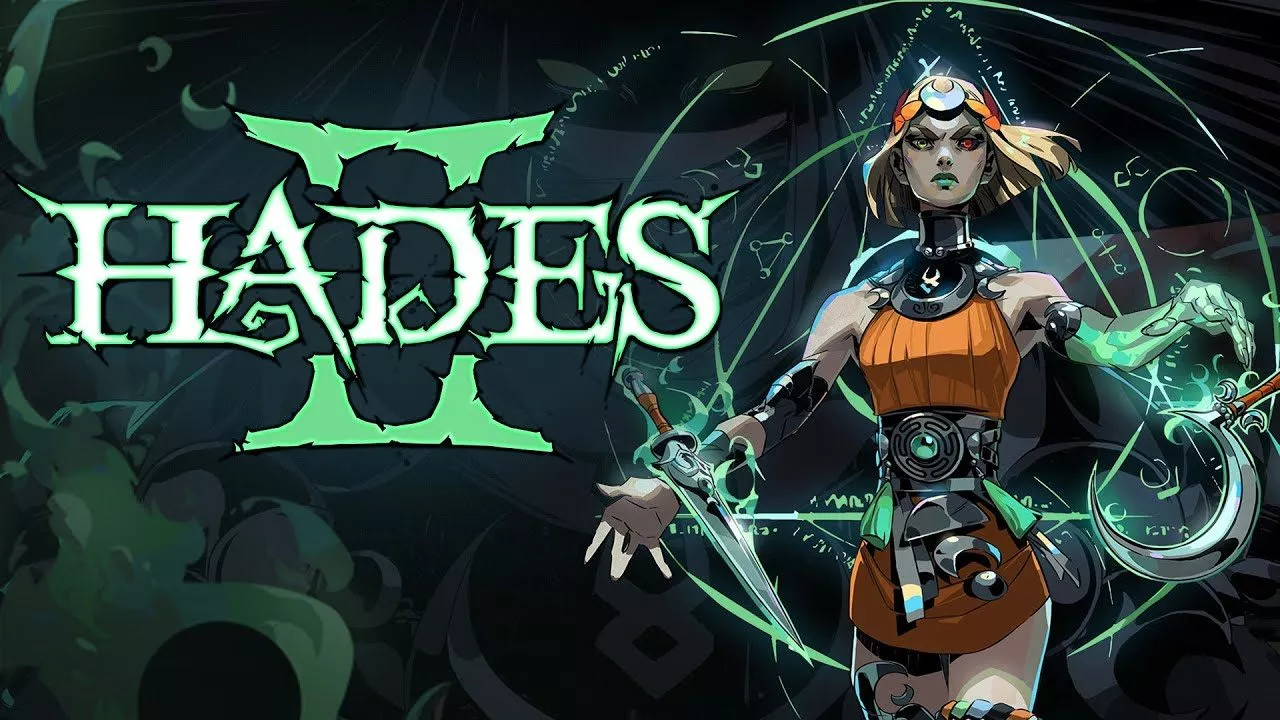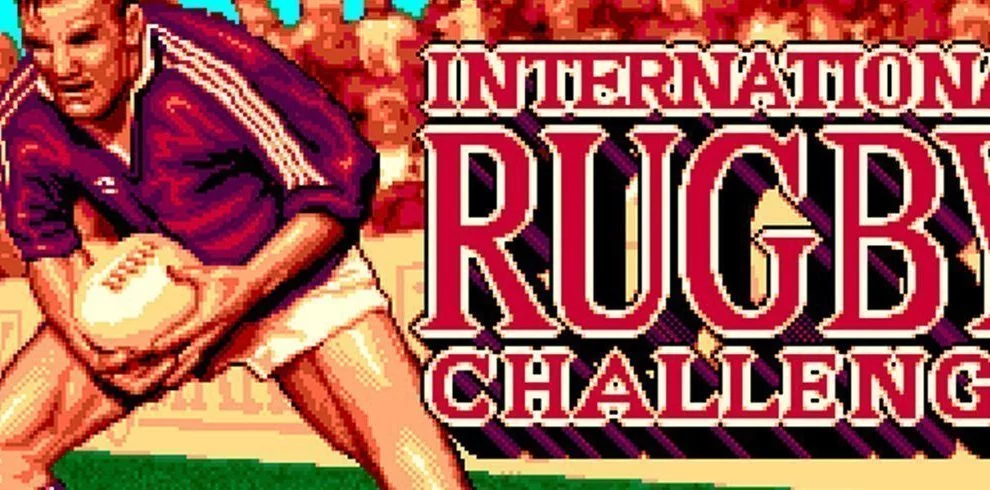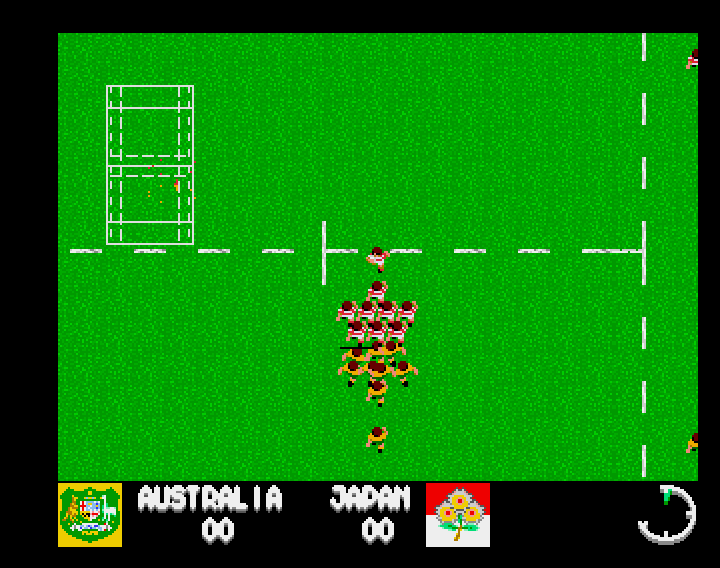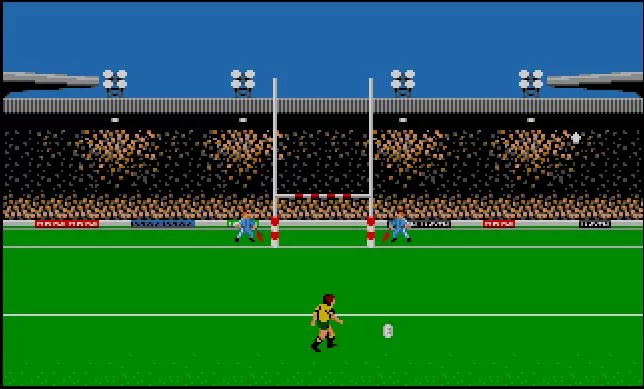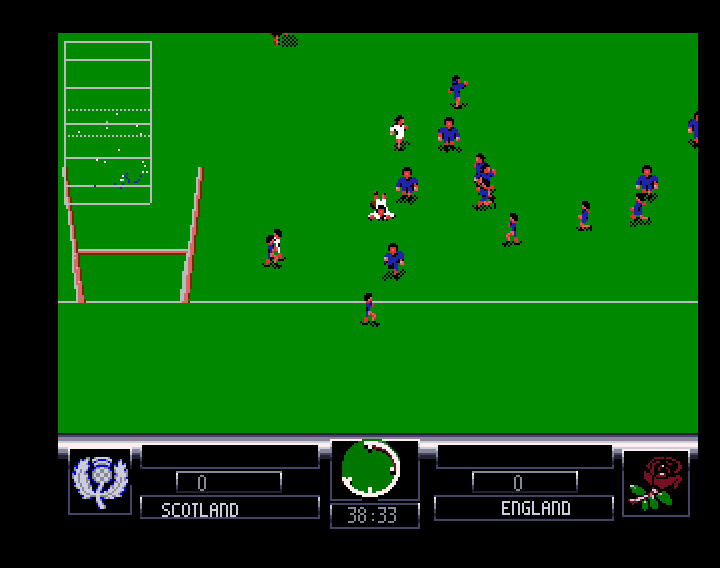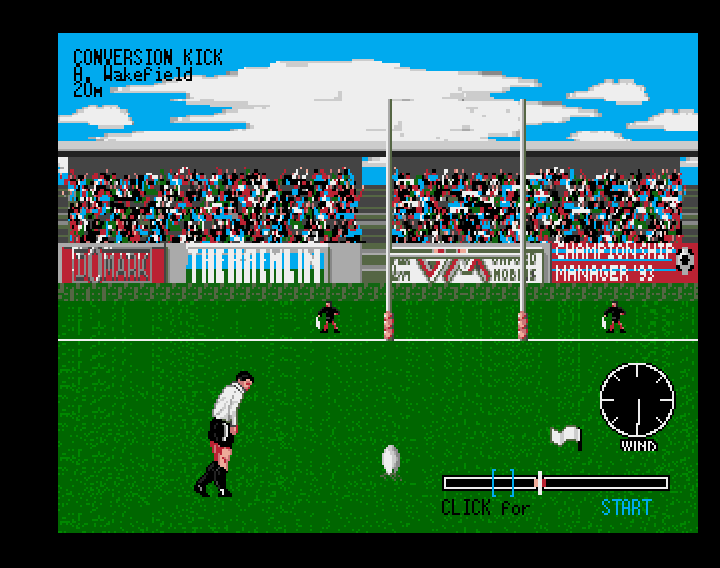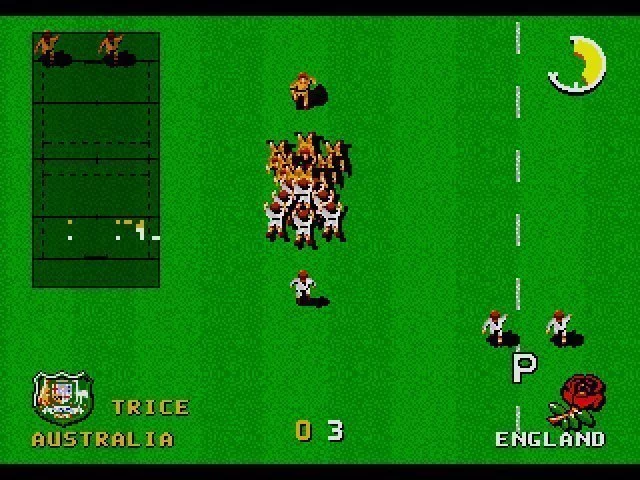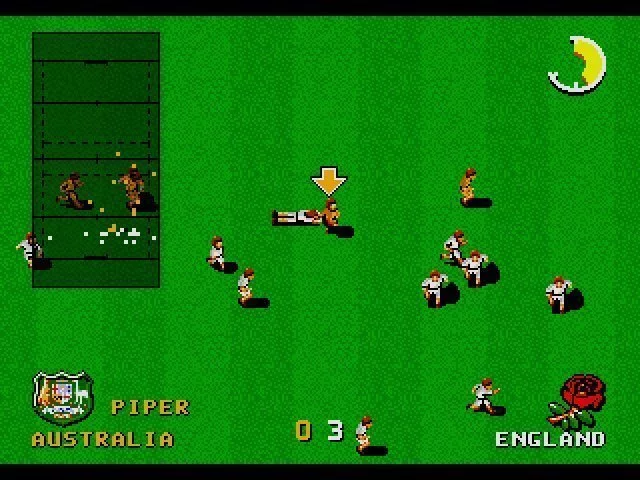One Game at a Time is a long standing mantra for sportsmen everywhere. It is sage advice on how to handle the stress of a long football season and an indicator of the maximum mental workload most footballers can handle. To me it is a good way to approach the history of rugby union and rugby league video games, making sure each title, no matter how terrible, is not overlooked.
Part I: Unlikely Beginnings | Part II: The Pre-Season | Part III: Goose-Step | Part IV: Days of Denton | Part V: Seriously, SNES? | Part VI: Give Yourself a Triple | Part VII: Lomu! | Part VIII: His Bad Knee
Goose-step
As the 80s turned to the 90s, the ZX Spectrum, Amstrad CPC and Commodore 64 made way for the Amiga and IBM PC. These powerful new machines saw game development step into a new era of enhanced graphics and enticing possibilities. While the flashy graphics took some time to make their way to rugby games there was a notable improvement in the quality of rugby simulations as the Amiga, PC and 16-bit consoles became the primary platforms.
That improvement mostly came from Denton Designs and Audiogenic, who we will be featuring in the next instalment. Today we look at the lesser of the two dominant rugby publishers of the early 90s, Domark Software (who in 1995 merged with Eidos Technologies and two other publishers to become a publisher you may have heard of; Eidos Interactive).
Rugby: The World Cup
- 1991 – Walking Circles, Domark Software
- Amiga, Atari ST (version played), Commodore 64
There is little to like about Rugby: The World Cup, but it is the most fully formed rugby simulation we have looked at so far. It is the first game to feature a full 15 players per side on the pitch and includes all 16 teams that contested the 1991 World Cup. Speaking of, Rugby: The World Cup was a cynical, unlicensed cash-in on the official tournament, rushed to market and branded in such a way to get maximum return from the World Cup license without having to spend a dime on it. Developer Carleton Handley had some choice quotes about Rugby: The World Cup for website Games That Weren’t, that sum up development:
“The whole project was a rush job to piggyback on the real rugby world cup which was going on in that year. I think Domark were after the licence but it fell through. We used the above name rather than the official “The Rugby World Cup” and it worked as most reviews treated it as the official game. I think Audiogenic did a much better Rugby game at the same time (World Class Rugby) but it didn’t sell as well as our “official” version!”
Rugby: The World Cup is the first game we have looked at that shows absolute contempt for a player’s wrists, relying on speedy joystick waggling to win scrums and by association, rucks. Rugby: The World Cup turns every ruck situation into a scrum, stopping play and warping all of the forwards into formation then letting the waggle begin. The skill of individual teams is represented by how fast you need to waggle to win a ruck meaning minnows such as Zimbabwe will go an entire match without winning a breakdown while New Zealand and England will do the same to any player with delicate wrists or in modern times, any level of concern for the survival of their gamepad or keyboard.
When you aren’t investing in future repetitive strain injuries the game is a lot more competent, with modest passing and running that sees ball carriers run twice as fast running at an angle than a straight line and AI using the patented “follow the ball carriers movements exactly, but five metres away” defensive pattern. Kicking is also reasonably handled, while the players don’t have strong boots on them it is easy enough to get the ball away into space or touch. Goal kicking brings you out to a behind the kicker view and asks you to stop a fast moving marker when it glides across the posts.
Rugby: The World Cup is simple and brutally exploitable, even when you cannot win a single waggle war. Running angles is enough to baffle the AI defenders meaning scoring a try is as simple as getting possession, easy when the AI is happy to pass to the ground or kick the ball away at regular intervals. You don’t win a match with skills and tactics, but rather by exploitation. As a result the game gets boring, fast, and multiplayer becomes frustrating once the laughter dies down. Rugby: The World Cup may have offered some enjoyment in its day but the game is too flawed and too exploitable to be considered anything more than a novelty.
Developers Walking Circles didn’t release too many more games after Rugby: The World Cup. They are probably best known for All Points Bulletin, the 1990 Atari game not the ill-fated shooter-MMO. Composer Matt Furniss had an extensive career in video game music production until the early 2000’s, spanning Psygnosis, Disney and Sony.
International Rugby Challenge (Campo’s International Rugby)
- 1993 – Oxford Mobius, Domark Software, Sega Ozisoft
- Amiga, PC (both versions played)
Domark had taken to calling themselves “Champions of Sport” by 1993, a dubious claim considering their second attempt at a rugby game is inexplicably worse than their debut in just about every way. Domark were indeed champions in one way, taking the crown for worst game ever in respected magazine Amiga Power, thanks to a 2/100 review score.
International Rugby Challenge was branded as Campo’s International Rugby for the Australian release in an effort to cash in on the popularity of goose-stepping Wallabies winger David Campese, which to be fair is what caught my eye as an 11 year old perusing walls of brightly coloured boxes at the Gamesmen. I ended up with the Amiga version of the game, my dominant memory being the terrifying ‘Guru Meditation’ errors (the Amiga equivalent to a BSOD) the game triggered if you dared to do something as complex as start a match or complete a tournament.
International Rugby Challenge is riddled with errors, from basic spelling mistakes to UI nightmares such as not being able to change the opposing side in a friendly unless you start a 2 player game (an option itself hidden two menus deep). On the pitch about the only thing the game does competently is kicking, an arrow emerging in front of your player when holding the fire button which makes executing long kicks relatively painless.
Rucks are contested by a bunch of player sprites walking on the spot near the ball and are won with joystick waggling, the ball spewing out ten metres backwards upon clearance. Tackling is near impossible unless the two player sprites overlap exactly, most tackle attempts end up looking like a particularly aggressive dive down a slip and slide.
The Amiga version of the game runs at slideshow pace, painful while the ball is in play and glacial when it goes into touch and you wait for the AI to retrieve it like a dejected child fielding another shot their older sibling has sent into the rose bushes. The PC game runs at a better clip though this doesn’t make it much more enticing to play.
AI is naturally terrible. They have a pinpoint kicking game, finding touch on the first bounce for maximum distance at every chance. Their running game may as well be assigned by random inputs and both your team and the AI defense enjoy running the same direction as the attacking player. You can easily run the length of the field by employing such devious tactics as zigzags, just as well because although passes are fast and accurate, triggering one is hit and miss while picking a direction is an even greater lottery. Ball physics are warped, with the ball able to bounce down a quarter of the field then stop on a dime.
A hideous goal kicking scene follows every try with a not-insignificant load time on the Amiga version. This scene doesn’t scale properly so kicking from in front of the posts results in midget touch judges and sideline conversions present a field wider than it is long. In a game riddled with technical failures they can best be summed up by one simple oversight: if you pause the game the clock doesn’t stop.
International Rugby Challenge deserves its reputation as one of the worst games ever made. Almost everything about it is worse than its predecessor and even ignoring the huge number of technical faults the game itself is not very much fun. Multiplayer doesn’t save it, the horrendous tackling sees to that, so I feel safe in saying that International Rugby Challenge has no redeeming features whatsoever.
Though International Rugby Challenge shares plenty of DNA with Rugby: The World Cup, development was handed over to Oxford Mobius who to that time were responsible for PC ports of games such as Pit-Fighter and Predator 2. Funnily enough this atrocity was their final release.
International Rugby
- 1993 – Tiertex, Domark
- Sega Mega Drive
International Rugby for the Mega Drive is technically a console port of International Rugby Challenge, but to consider the two related would do the Sega edition a massive disservice. Tiertex has cleaned up most of the faults with the home computer version and made a tight and playable game.
What only comes through as glimpses of intent in the computer versions becomes a fully realised rugby game on Sega’s 16 bit console. I won’t go so far as to call International Rugby fun, it is rather dull and simplistic, but it is easily the most competent and authentic rugby game we have looked at thus far.
With three buttons to work with you can now choose to pass left or right, though passes find the ground far too often to be reliable. Kicking is handled with another button, using the same extending arrow system of the computer versions. You now have a switch player button alongside tackle but if anything defence is harder in this version, a perfect overlap is required to make a tackle and amusingly the tackle percentage is provided in the post game statistics screen, mine would regularly sit below 10% success rate, the AI not much better. Rucks are won by bashing buttons which feels positively progressive after joystick waggling.
Speaking of the AI, it mostly consists of clearing kicks taking a perfect bounce one foot inside the touchline. You will spend most of your game time in lineouts, mercifully they are easily won with the throw using a simple two click metre. When the AI does decide to run you are in big trouble thanks to the terrible tackling, but most of the time the computer will convert its hard earned territory into field goals rather than run for the line.
International Rugby even implements penalties, at least for not clearing the ball out of the scrum in time. Sure you can’t control the kick to touch should you choose that option, but it is the thought that counts. Tiertex even figured out how to fix player movement speed, now you run just as fast on diagonals as you do in a straight line. This meant I had to use some semblance of actual strategy to score tries in International Rugby, though zigzags and dodging were still overly effective.
International Rugby is tight enough that it presents an interesting multiplayer game for those that don’t mind the horrendous tackling. Single player quickly becomes a bore as you wait for lineouts to form and grind your way down the field, and even for the quality of games at the time this was below average. Sadly, below average is still enough to make International Rugby the best rugby game released to this point.
Tiertex had a long run as a port studio, eventually becoming known for their handheld releases of EA Sports games and movie licenses for the Gameboy and its successors. Their ZX Spectrum port of Street Fighter 2 is a notable achievement, even if the game itself is terrible. They disappeared in 2003, apparently to now sell PC hardware under the same name.
THE CRITICS
The change in games criticism from 1991 to 1993 is best highlighted by Amiga Power, who went from generous and positive to brutally, hilariously critical in that time. In 1991 current Polygon writer Colin Campbell gave a glowing review and 85% score to Rugby: The World Cup in Amiga Power, calling it “a sports simulation in the truest sense of the phrase” and “a Godsend”. Two years later Amiga Power editor Stuart Campbell made history by giving International Rugby Challenge the magazine’s lowest score of all time, 2%.
Amiga Power weren’t alone, with most reviews for Rugby: The World Cup sitting in the 70-80% range. International Rugby Challenge was panned in comparison, aside from the 2% Amiga Power dished out only a handful of outlets scored the game above 50%. Stuart Campbell’s review has become a thing of legend, largely thanks to comparing the war in Bosnia and famine in Somalia favourably with International Rugby Challenge.
Next time: Audiogenic, Denton Designs and Andrew Ettingshausen bring us the very first digital version of rugby league.
This article may contain affiliate links, meaning we could earn a small commission if you click-through and make a purchase. Stevivor is an independent outlet and our journalism is in no way influenced by any advertiser or commercial initiative.




